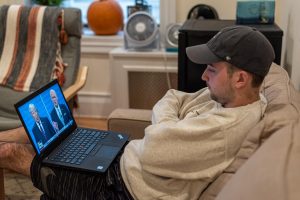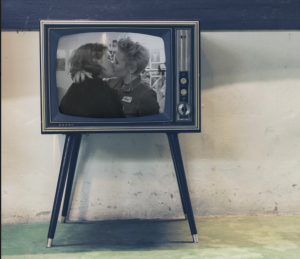TV, the Modern Bonfire, Unites Families to Their Roots and to Each Other
Television remains a communal American tradition for the twenty-first-century family
August 1, 2021
Growing up during the ’90s in a small suburb of Long Island, my family frequently gathered around our 12-inch Sharp CRT television. We didn’t think much of it, but these were the few opportunities when the family was relatively quiet, together and focused on one thing — the TV.
TV watching became our shared ritual, like a modern bonfire. We were all called to drop our worldly responsibilities to gather and watch a spectacle of sorts. It was a time to recharge, relax and regroup as a family.
My father would call us at a moment’s notice. My brothers and I would jump to our feet, scurrying down the stairs to our living room. My father would fumble with the VCR while my younger brother would sit with his legs crossed adjacent to him, eagerly waiting for the picture to appear on the screen. We went through all the classics, from Indiana Jones and Star Wars to James Bond and “Jaws.”
A few years passed, and our family’s strength waned.
As responsibilities grew and our time living together was no more, family TV time ceased to be. My older brother spent much of his time at work or traveling. My younger brother moved to Manhattan and was working more than he slept. My sister became a nurse and later moved to Manhattan as well. I was out in eastern Long Island, Ronkonkoma — “no man’s land.”
A few years passed, and our family’s strength waned. We had mourned the sudden loss of my younger brother, Stephen. My father developed dementia and his memory was quickly falling into its abyss. We fought over whether to even celebrate the holidays anymore. Christmas, usually the most joyful of times, seemed empty. I sat in front of my TV, tossing the remote aside, thinking, “This was it; this was our family life now.”
Our fire had burned out.
A few laughs and gasps helped to kindle our fire, and soon it was full ablaze.
Christmas came, and I had a change of heart. I decided on a hopeful beginning, so I brought my Blu-Ray player with a few backed-up films to hopefully spark the lost fire within our family.
My sister and her boyfriend were eager to watch something, as was my mother. My father was apathetic for the most part but seemed to be enjoying the family reunion. My older brother was too busy scooting around with our dogs, so we decided to give the TV a try. My sister picked a show from HBO Max, “The Flight Attendant.” None of us really cared what the show was, as long as something was on and we were together again as a family.
A few laughs and gasps helped to kindle our fire, and soon it was full ablaze.
We were all enjoying each other’s presence — that’s the real joy of movie-watching at home.
It was just my family, the five of us and my sister’s boyfriend, which made this moment even more memorable. Christmas was no longer about all the fancy gifts, the food or even the gathering of the extended family. It was about us and our modern bonfire.
At the start, I still felt my late younger brother there, ready to tear my older brother’s head off for making so much racket during the show — “Shhhh! Shhh! Tommy! Be quiet!” — and I could still see the look on Tom’s face: It would match poor old Rudolph’s, wishing to be a part of Santa’s sleigh.
But it was just us and the “tube,” with my sister’s boyfriend nudging me to play Christopher Nolan’s new hit film, “Tenet.” We all sat around watching the show. Maybe entertained, maybe not, I didn’t know for sure, but what did it matter? We were all enjoying each other’s presence — that’s the real joy of movie-watching at home.
We all huddled around in the frost of the day and night by the fireplace.
2012 had a similar vibe to last Christmas. That year, Hurricane Sandy hit Long Island hard. Our town was painted with fallen trees and other debris. We lost power for 2 weeks, but still our modern bonfire was lit. We all huddled around in the frost of the day and night by the fireplace. Luckily, my laptop had enough juice for us to watch “Freaks and Geeks.” I still can’t forget repeatedly watching the awkwardness of Martin Starr and laughing as if his antics could never get old.
We were grateful to have limited damage to our home, but even more grateful that we had weathered the storm. Across the globe, many encountered a similar housebound predicament with the outbreak of COVID-19.
TV became essential during the lockdown and quarantine, so much so that in the spring of 2020, consumers purchased TVs at levels typically seen during the holidays. Sales of TVs larger than 65 inches were up 77% in April through June, although it was projected only to increase 20%.
“During the pandemic, TVs have served as a refuge for people, as we have seen double-digit increases in sound bars, steaming players, and mounts,” according to Stephen Baker, vice president of industry analysis for the NPD Group.
TV programming, sports and movies have provided an outlet for the anxiety during COVID-19, allowing for the creation of bonds between family and friends. The possibilities are endless with the vast amount of choices between streaming services, cable television and physical media. If families wanted to enjoy their favorite bands, they could easily set up an outdoor venue to simulate the actual concert. The same applies to sporting events as well. Distant family or friends could make a night of watching TV live together through video chats. Whether in person or virtual, the TV plays an integral part in modern communal living.
Although families and situations may change, television holds an essential place in family life, and it has for many years. Its evolution lies in the heart of the American families solidifying their strength around the modern bonfire.

















